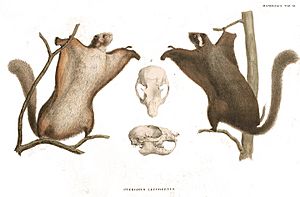Japanese giant flying squirrel facts for kids
Quick facts for kids Japanese giant flying squirrel |
|
|---|---|
 |
|
| Conservation status | |
| Scientific classification | |
| Genus: |
Petaurista
|
| Species: |
leucogenys
|
The Japanese giant flying squirrel (Petaurista leucogenys) is a fascinating animal found only in Japan. It's not a typical squirrel that runs on the ground. Instead, it's a special type of squirrel that can glide through the air! These amazing creatures are known for their large eyes and their ability to "fly" from tree to tree.
Contents
What Does It Look Like?
The Japanese giant flying squirrel is quite big for a squirrel. Its body can be anywhere from 25 to 50 centimeters (about 10 to 20 inches) long. That's about the size of a small cat! It also weighs between 700 and 1500 grams (about 1.5 to 3.3 pounds).
These squirrels have soft, brown fur that helps them blend in with the trees. They have very large, dark eyes that help them see well in the dark, as they are mostly active at night. The most unique part of their body is a special flap of skin called a patagium. This skin stretches from their wrists to their ankles. When they spread their limbs, this skin forms a parachute-like surface, allowing them to glide.
Where Does It Live?
The Japanese giant flying squirrel lives only in Japan. You can find them in the dense forests on the islands of Honshu, Shikoku, and Kyushu. They prefer old-growth forests with tall trees. These trees provide them with plenty of places to find food and safe spots to build their nests. They often make their homes in tree hollows or cavities.
What Does It Eat?
These squirrels are mostly herbivores, meaning they eat plants. Their diet mainly consists of fruits and seeds. They also enjoy munching on nuts, buds, and the bark of trees. Sometimes, they might even eat insects. They use their strong teeth to crack open tough seeds and nuts.
Life Cycle and Reproduction
The breeding season for the Japanese giant flying squirrel usually runs from winter to early summer. During this time, the female squirrel will give birth to one or two young. The baby squirrels are born helpless and rely completely on their mother for care. They grow quickly and learn to glide at a young age. This helps them become independent and find their own food and shelter.
What Threats Does It Face?
Sadly, the Japanese giant flying squirrel faces some challenges. One of the biggest threats is the cutting down of forests. When trees are cut down, these squirrels lose their homes and their food sources. This is called habitat loss. It's important to protect their forest homes so these unique animals can continue to thrive.
Relationship with Humans
In the past, Japanese giant flying squirrels were sometimes hunted by people. However, today, there's more focus on protecting them. Some people even keep them as pets, though it's important to remember that wild animals have specific needs. Conservation efforts are in place to ensure these amazing gliders have a safe future in their natural habitats.
See also
 In Spanish: Ardilla voladora gigante japonesa para niños
In Spanish: Ardilla voladora gigante japonesa para niños


